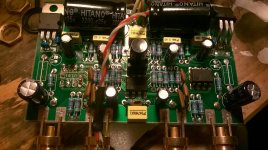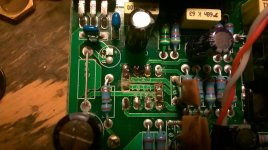Keeping my fingers crossed that you can get the appropriate information, but knowing whether or not the op-amp is a single or dual would be helpful in the event that you need to substitute something else.
How about some pictures? (Post here using advanced mode / browse / upload)
(Post here using advanced mode / browse / upload)
How about some pictures?
Correction: I checked the PCB and the V+ goes to pin 8. V- is pin 4, you can see this on the close up image, pin 4 goes to bare wire jumper to the left which is V- out on the 7918 DC/DC converter.
This review is talking about the Clearaudio Basic+ (I have the Basic) and Burr-Brown OP amps. Perhaps the Basic is using a OPA2134? At least the V- and V+ pins match the PCB layout. Not sure about the rest.
This review is talking about the Clearaudio Basic+ (I have the Basic) and Burr-Brown OP amps. Perhaps the Basic is using a OPA2134? At least the V- and V+ pins match the PCB layout. Not sure about the rest.
With pin 8 as plus they are duals (as your likely list shows). OPA2604 is a good performer and pretty universal. For a bjt type it has to be the LM4562 
Change both opamps so you keep L and R identical, maybe fitting sockets so you can have a play later.
A tip for removing them from double sided print. Snip each leg and remove the opamp. Then heat and pull each remaining pin from the PCB. Then use a piece of stainless wire to run through the hole (solder won't take to stainless) and use braid to clean up the excess solder. Clean with ISO and it should look like new.
Change both opamps so you keep L and R identical, maybe fitting sockets so you can have a play later.
A tip for removing them from double sided print. Snip each leg and remove the opamp. Then heat and pull each remaining pin from the PCB. Then use a piece of stainless wire to run through the hole (solder won't take to stainless) and use braid to clean up the excess solder. Clean with ISO and it should look like new.
Greetings.
I'm repairing a friend's Clearaudio Basic. One of the OPs needs to be replaced. The DIL-8 case is scrubbed and the label is unreadable. Does anyone know which OP is used in Clearaudio Basic?
Regards,
Arvid
I realise it's been a while but, if you still have the dead opamp, you can heat the IC's plastic enclosure with a heat gun to 550 deg C and carefully remove the plastic encapsulant, use a pair side cutters to snip away from the edges, while holding it with long nose pliers.
Use a stand to grip and hold the heatgun in a fixed convenient position.
At the right temp, the case will split and reveal the silicon die - it's usually tiny around 3x3 mm or less. Under a 10x microscope you should be able to read the manufacturuer's part number on the silicon die:
TI (BB), Analog Devices, Nat Semi all put the part number on the die next/near to one of the pads for the power pins.
e.g. for the AD825 opamp, you'll see '825' on the die. For the TI OPA2134, they just put 'TI' '2134'. Similar NEC UPC324 is 'NEC' 'C324', PHILIPS/NXP is just 5534A for the NE5534AN. Also, you should see the vendor's logo on the die, 'AD' Analog Devices.
Make sure you have a respirator on when heating the plastic encapuslant - the fumes are toxic.
Also wear safety glasses and gloves.
As for the heat gun, I've used a Steinel HG 2320 ESD - that's what we have at work. The Steinel HG 2310 LCD is good too.
Use the low fan setting. Be patient, it takes about 20-40s of direct heat to get the IC's encapuslant soft enough to break-up gently and crumble.
Be cautious at first - practice on another chip if it helps.
Having been through the same hassle with another Clearaudio preamp and told to send it to Germany for repair - The opamp in my case was an LM4562 - the silicon die just had 'NS' and '4562' on it.
I don't know why they're so paranoid about giving the information; Sanding the name off a chip doesn't stop anyone in the end...
I know of companies in Romania and China where you can send the product to and for around USD500-1000 they'll come back with a complete verified schematic and details of all semiconductors, right down to transitor gains, you name it if you ask for it...and you're prepared to pay
Good luck!
Last edited:
- Status
- This old topic is closed. If you want to reopen this topic, contact a moderator using the "Report Post" button.
- Home
- Source & Line
- Analogue Source
- Which OP in Clearaudio Basic

